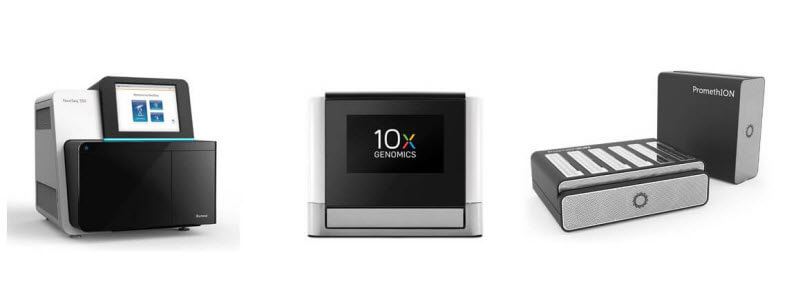 
Plateforme de génomique, IPMC UMR7275 660 Route des Lucioles, SOPHIA ANTIPOLIS, 06560 VALBONNE tél: 04-93-95-77-77, fax: 04-93-95-77-08 |
|
Expertise
La plateforme de génomique fonctionnelle de Nice Sophia Antipolis existe depuis 1999.
Initialement orientée vers la conception, la fabrication et l'analyse de puces à ADN, elle a contribué à ouvrir cette nouvelle technologie à
une large communauté, mettant à cette occasion en place un système d'information performant (Mediante),
capable de gérer de grandes masses de données, et fonctionnant en production depuis plus de 20 ans.
Equipements

Les résultats sont stockés automatiquement sur le portail d'informations de la plateforme Mediante. Cela concerne notamment les fichiers .BAM d'alignement, les fichiers .BW de couverture et l'ensemble des fichiers de l'analyse secondaire et des analyses statistiques conduites en partenariat avec le collaborateur. Sur demande l'ensemble des données brutes sont également mises à disposition et une aide est fournit pour la soumission des données vers la base de données publiques GEO (Gene Expression Omnibus). |
Related publicationsRostagno Philippe2 publications found1. Accelerated arterial stiffening and gene expression profile of the aorta in patients with coronary artery disease., J Hypertens. 2008 Apr;26(4):747-57 (Pubmed: 18327085)Fassot C, Briet M, Rostagno P, Barbry P, Perret C, Laude D, Boutouyrie P, Bozec E, Bruneval P, Latremouille C, Laurent S Hypertension and chronic renal failure (CRF) are considered models of accelerated arterial stiffening. Arterial stiffness increases further when CRF is associated with hypertension. We hypothesized that, in patients with mild CRF, aortic gene expression profile would include genes involved in arterial calcifications and enlargement. METHOD: We analysed human aorta with the 'GeneChip Microarray' technology, in patients with or without CRF, scheduled for a coronary artery bypass graft. RESULTS: Nine of 25 patients had high-quality RNA and were included in the study. Among the 101 transcripts differentially expressed between CRF patients and controls, 97 transcripts were overexpressed in CRF patients. Two genes had the highest overexpression in CRF patients: lumican (LUM), involved in the regulation of collagen fibrillogenesis; and ornithine decarboxylase (ODC1), involved in polyamine biosynthesis, smooth muscle cell growth and proliferation. Immunohistochemical staining revealed an increased amount of LUM and ODC1 in the vascular smooth muscle cells (VSMCs) of CRF compared to non-CRF aortic sections. Eight genes were implicated in the regulation of the cytoskeleton (including capping protein muscle Z-line 1 alpha and moesin) and cell migration, and five genes were implicated in extracellular matrix function and apoptosis. A trend towards an upregulation of candidate genes involved in arterial calcifications was observed in CRF patients, but did not reach statistical significance. Carotid-femoral pulse wave velocity was not correlated with gene expression level. CONCLUSION: In conclusion, these results show that patients at an early stage of CRF have a specific gene expression profile of aortic tissue and suggest that genes implicated in collagen fibrillogenesis, and VSMCs migration and proliferation, particularly LUM and ODC1, may play a role. 2. An open-access long oligonucleotide microarray resource for analysis of the human and mouse transcriptomes., Nucleic Acids Res. 2006 Jul 19;34(12):e87 (Pubmed: 17384016) Le Brigand K, Russell R, Moreilhon C, Rouillard JM, Jost B, Amiot F, Magnone V, Bole-Feysot C, Rostagno P, Virolle V, Defamie V, Dessen P, Williams G, Lyons P, Rios G, Mari B, Gulari E, Kastner P, Gidrol X, Freeman TC, Barbry P Two collections of oligonucleotides have been designed for preparing pangenomic human and mouse microarrays. A total of 148,993 and 121,703 oligonucleotides were designed against human and mouse transcripts. Quality scores were created in order to select 25,342 human and 24,109 mouse oligonucleotides. They correspond to: (i) a BLAST-specificity score; (ii) the number of expressed sequence tags matching each probe; (iii) the distance to the 3' end of the target mRNA. Scores were also used to compare in silico the two microarrays with commercial microarrays. The sets described here, called RNG/MRC collections, appear at least as specific and sensitive as those from the commercial platforms. The RNG/MRC collections have now been used by an Anglo-French consortium to distribute more than 3500 microarrays to the academic community. Ad hoc identification of tissue-specific transcripts and a approximately 80% correlation with hybridizations performed on Affymetrix GeneChiptrade mark suggest that the RNG/MRC microarrays perform well. This work provides a comprehensive open resource for investigators working on human and mouse transcriptomes, as well as a generic method to generate new microarray collections in other organisms. All information related to these probes, as well as additional information about commercial microarrays have been stored in a freely-accessible database called MEDIANTE. |